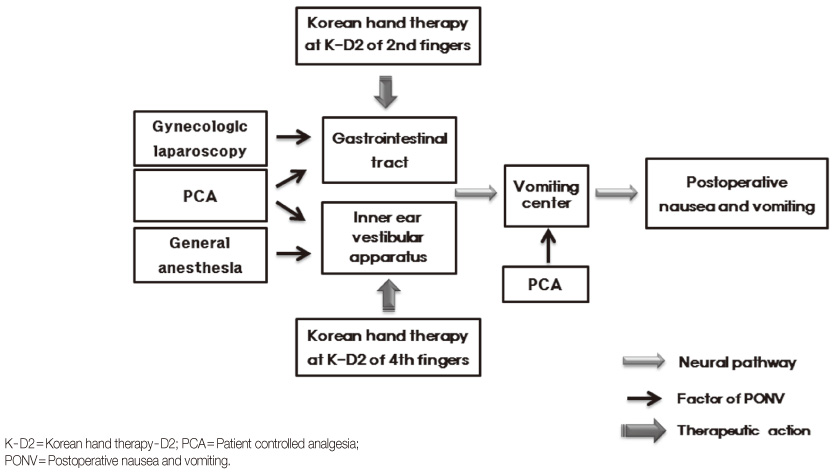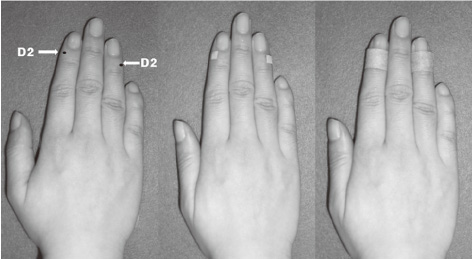J Korean Acad Nurs.
2013 Apr;43(2):215-224. 10.4040/jkan.2013.43.2.215.
Combination Effects of Capsicum Plaster at the Korean Hand Acupuncture Points K-D2 with Prophylactic Antiemetic on Postoperative Nausea and Vomiting after Gynecologic Laparoscopy
- Affiliations
-
- 1Department of Nursing, Cheongju University, Cheongju, Korea.
- 2College of Nursing, Kyungpook National University, Daegu, Korea. syepark@knu.ac.kr
- KMID: 1739485
- DOI: http://doi.org/10.4040/jkan.2013.43.2.215
Abstract
- PURPOSE
This study was done to evaluate the combination effects of capsicum plaster at the Korean hand acupuncture points K-D2 with prophylactic antiemetic on Postoperative Nausea and Vomiting (PONV).
METHODS
An experimental research design (a randomized, a double-blinded, and a placebo-control procedure) was used. The participants were female patients undergoing gynecologic laparoscopy; the control group (n=34) received intravenous prophylactic ramosetron 0.3mg, while the experimental group (n=34) had Korean Hand Therapy additionally. In the experimental group, capsicum plaster was applied at K-D2 of both 2nd and 4th fingers by means of Korean Hand Therapy for a period of 30 minutes before the induction of anesthesia and removed 8 hours after the laparoscopy.
RESULTS
The occurrence of nausea, nausea intensity and need for rescue with antiemetic in the experimental group was significantly less than in the control group 2 hours after surgery.
CONCLUSION
Results of the study show capsicum plaster at K-D2 is an effective method for reducing PONV in spite of the low occurrence of PONV because of the prophylactic antiemetic medication.
Keyword
MeSH Terms
-
Acupuncture Points
Adult
Anesthesia
Antiemetics/*therapeutic use
Asian Continental Ancestry Group
Capsaicin/therapeutic use
Capsicum/*chemistry
Double-Blind Method
Female
Fingers
Genital Diseases, Female/*surgery
Humans
Laparoscopy/adverse effects
Middle Aged
Postoperative Nausea and Vomiting/*drug therapy/etiology
Republic of Korea
Time Factors
Vomiting/*drug therapy/etiology
Antiemetics
Capsaicin
Figure
Cited by 1 articles
-
Effects of Preoperative Dehydration on Postoperative Nausea and Vomiting in Gynecological Surgery Patients
Yunjeong Hwang, SoMi Park
Korean J Women Health Nurs. 2015;21(1):23-31. doi: 10.4069/kjwhn.2015.21.1.23.
Reference
-
1. Agarwal A, Dhiraaj S, Tandon M, Singh PK, Singh U, Pawar S. Evaluation of capsaicin ointment at the Korean hand acupressure point K-D2 for prevention of postoperative nausea and vomiting. Anaesthesia. 2005. 60(12):1185–1188. http://dx.doi.org/10.1111/j.1365-2044.2005.04402.x.2. Apfel CC, Kranke P, Katz MH, Goepfert C, Papenfuss T, Rauch S, et al. Volatile anaesthetics may be the main cause of early but not delayed postoperative vomiting: A randomized controlled trial of factorial design. Br J Anaesth. 2002. 88(5):659–668.3. Apfel CC, Läärä E, Koivuranta M, Greim CA, Roewer N. A simplified risk score for predicting postoperative nausea and vomiting: Conclusions from cross-validations between two centers. Anesthesiology. 1999. 91(3):693–700.4. Bailey PL, Streisand JB, Pace NL, Bubbers SJ, East KA, Mulder S, et al. Transdermal scopolamine reduces nausea and vomiting after outpatient laparoscopy. Anesthesiology. 1990. 72(6):977–980.5. Berkley KJ, Robbins A, Sato Y. Functional differences between afferent fibers in the hypogastric and pelvic nerves innervating female reproductive organs in the rat. J Neurophysiol. 1993. 69(2):533–544.6. Boehler M, Mitterschiffthaler G, Schlager A. Korean hand acupressure reduces postoperative nausea and vomiting after gynecological laparoscopic surgery. Anesth Analg. 2002. 94(4):872–875. table of contents.7. Chi JG. Medical dictionary: English-Korean, Korean-English. 2006. Anyang: Academya.8. Dundee JW, Ghaly RG, Bill KM, Chestnutt WN, Fitzpatrick KT, Lynas AG. Effect of stimulation of the P6 antiemetic point on postoperative nausea and vomiting. Br J Anaesth. 1989. 63(5):612–618.9. Eo HJ. The effect of oral cryotherapy on postoperative nausea and vomiting after laparoscopic surgery. 2010. Seoul: Ewha Womans University;Unpublished master's thesis.10. Gan TJ, Glass PS, Sigl J, Sebel P, Payne F, Rosow C, et al. Women emerge from general anesthesia with propofol/alfentanil/nitrous oxide faster than men. Anesthesiology. 1999. 90(5):1283–1287.11. Gan TJ, Meyer T, Apfel CC, Chung F, Davis PJ, Eubanks S, et al. Consensus guidelines for managing postoperative nausea and vomiting. Anesth Analg. 2003. 97(1):62–71.12. Iitomi T, Toriumi S, Kondo A, Akazawa T, Nakahara T. Incidence of nausea and vomiting after cholecystectomy performed via laparotomy or laparoscopy. Masui. 1995. 44(12):1627–1631.13. Jung SH, Jeon YH. Antiemetic effect of midazolam added to patient-controlled analgesia after total abdominal hysterectomy. Korean J Anesthesiol. 2006. 51(5):591–597.14. Kim EJ, Ko JS, Kim CS, Lee SM, Choi DH. Combination of antiemetics for the prevention of postoperative nausea and vomiting in high-risk patients. J Korean Med Sci. 2007. 22(5):878–882.15. Kim KS, Koo MS, Jeon JW, Park HS, Seung IS. Capsicum plaster at the Korean hand acupuncture point reduces postoperative nausea and vomiting after abdominal hysterectomy. Anesth Analg. 2002. 95(4):1103–1107.16. Kim MW. Postoperative nausea and vomiting. Dongguk J Med. 2004. 11(1):151–156.17. Kim NC, Yoo JB, Cho MS, Shin EJ, Hahm TS. Effects of Nei-Guan acupressure on nausea, vomiting and level of satisfaction for gynecological surgery patients who are using a patient-controlled analgesia. J Korean Acad Nurs. 2010. 40(3):423–432. http://dx.doi.org/10.4040/jkan.2010.40.3.423.18. Kim TS, Choi SE, Won RS. Undesirable symptoms of patients in the postanesthesia recovery situations. Korean J Anesthesiol. 2001. 40(5):619–624.19. Kovac AL. Prevention and treatment of postoperative nausea and vomiting. Drugs. 2000. 59(2):213–243.20. Marston A. Responses of the splanchnic circulation to ischaemia. J Clin Pathol Suppl (R Coll Pathol). 1977. 11:59–67.21. Namsan Sŭim. Plaster therapy of miracle. 1999. Seoul: Myung Sang.22. Ogata A, Yamada Y, Sugiura M, Takayanagi R, Sawada Y, Iga T. Analysis of 5-HT3 receptor antagonist, ramosetron hydrochloride, based on receptor occupancy considering its active metabolite. Yakugaku Zasshi. 2001. 121(11):793–798.23. Oh SY, Park KS, Hwang YY. The effect of ethanol inhalation on postoperative nausea in patients using patient controlled analgesia. J Korean Acad Adult Nurs. 2009. 21(4):379–390.24. Park HH, Park KS, Lee SY, Cho OG, Kim JH, Kim JS, et al. The effects of prophylactic metoclopramide and induction with propofol on postoperative nausea and vomiting. Korean J Anesthesiol. 2006. 50(2):179–183.25. Schlager A, Boehler M, Puhringer F. Korean hand acupressure reduces postoperative vomiting in children after strabismus surgery. Br J Anaesth. 2000. 85(2):267–270.26. Suh JK, Bae DJ, Cho SY, Jeon WJ. The assessment of postoperative nausea and vomiting (PONV) using rhodes index in PONV high risk group. Korean J Anesthesiol. 2008. 54(3):278–282. http://dx.doi.org/10.4097/kjae.2008.54.3.278.27. Watcha MF, White PF. Postoperative nausea and vomiting. Its etiology, treatment, and prevention. Anesthesiology. 1992. 77(1):162–184.28. White PF, O'Hara JF, Roberson CR, Wender RH, Candiotti KA. The impact of current antiemetic practices on patient outcomes: A prospective study on high-risk patients. Anesth Analg. 2008. 107(2):452–458. http://dx.doi.org/10.1213/ane.0b013e31817b842c.29. Yang SY, Kim YH, Kang PS, Yoon SH. The effect of anaesthetic technique on postoperative nausea and vomiting in patients undergoing gynecologic laparoscopy. Korean J Anesthesiol. 2003. 45(3):332–338.30. Yoo TW. Seokeum therapy lecture. 2008. Seoul: Koryo Sooji Chim.
- Full Text Links
- Actions
-
Cited
- CITED
-
- Close
- Share
- Similar articles
-
- Antiemetic efficacy of capsicum plaster on acupuncture points in patients undergoing thyroid operation
- Postoperative nausea and vomiting after capsicum plaster at the P6 acupoint after laparoscopic cholecystectomy according to gender
- Effect of capsicum plaster at the P6 acupoint on postoperative nausea and vomiting in patients undergoing endoscopic sinus surgery
- Effects of Capsicum Plaster at the Korean Hand Acupuncture Point on Pain Management after Knee Replacement
- The Effect of Anaesthetic Technique on Postoperative Nausea and Vomiting in Patients undergoing Gynecologic Laparoscopy



